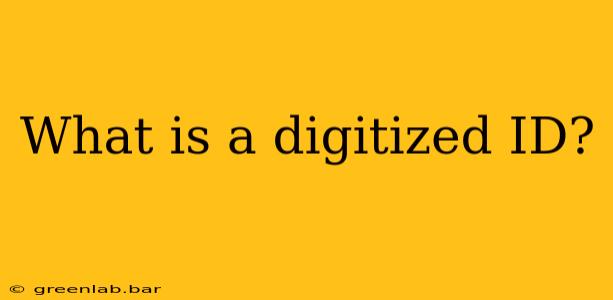In today's increasingly digital world, the need for secure and efficient identity verification has never been greater. This has led to the rise of digitized IDs, a crucial element in online security and streamlined processes. But what exactly is a digitized ID? This comprehensive guide will explore the concept, its benefits, security considerations, and its impact on various sectors.
Understanding Digitized IDs: More Than Just a Scan
A digitized ID isn't simply a scanned copy of your physical identification document, like a driver's license or passport. While a scan might be a part of the process, a true digitized ID goes much further. It involves transforming the information contained within your physical ID into a secure, verifiable digital format. This often includes:
- High-resolution image: A clear, detailed scan of the physical ID, capturing all relevant information and security features.
- Data extraction: Key information, such as name, date of birth, and ID number, is extracted from the image and stored securely. This data is often structured for easy verification.
- Security features: Digitized IDs incorporate security measures to prevent forgery and tampering. This might involve encryption, digital signatures, or blockchain technology.
- Verification mechanisms: The system used to create and manage the digitized ID usually includes ways to verify its authenticity, often through comparison with official databases or using biometric data.
The Advantages of Digitized IDs
The shift towards digitized IDs offers numerous benefits for individuals, businesses, and governments alike:
For Individuals:
- Increased convenience: Accessing services and verifying your identity becomes significantly easier and faster. No more needing to carry physical documents everywhere.
- Enhanced security: Digitized IDs can offer greater protection against theft or loss compared to physical IDs. Many systems employ robust security protocols to prevent unauthorized access.
- Improved privacy: With proper implementation, digitized ID systems can offer better control over personal data compared to sharing physical documents.
For Businesses:
- Streamlined processes: Verifying customer identities becomes automated and efficient, reducing processing times and operational costs.
- Reduced fraud: Robust verification processes significantly reduce the risk of identity theft and fraudulent activities.
- Improved customer experience: Faster and more convenient onboarding and verification processes lead to happier customers.
For Governments:
- Enhanced security: Stronger identity verification systems contribute to national security and help combat fraud and identity theft.
- Improved efficiency: Government services can be delivered more efficiently with streamlined identity verification.
- Better data management: Consolidated and secure digital identity systems can improve the management of citizen data.
Security Concerns and Mitigation Strategies
While digitized IDs offer significant advantages, security remains a paramount concern. Potential risks include:
- Data breaches: Robust security measures, including encryption and access controls, are vital to protect sensitive personal data.
- Identity theft: Strong authentication and authorization mechanisms are crucial to prevent unauthorized access and manipulation of digital IDs.
- System vulnerabilities: Regular security audits and updates are essential to mitigate potential vulnerabilities in the system.
To address these concerns, strong security protocols are vital. This includes:
- Encryption: Protecting data in transit and at rest using strong encryption algorithms.
- Multi-factor authentication: Requiring multiple forms of verification to access digital IDs.
- Regular security audits: Conducting regular assessments to identify and address vulnerabilities.
- Data minimization: Storing only the necessary data required for verification.
The Future of Digitized IDs
The use of digitized IDs is rapidly expanding across various sectors, from financial services and healthcare to government services and travel. As technology continues to evolve, we can expect further advancements in security and usability. The integration of biometric authentication, blockchain technology, and decentralized identity systems is likely to play a significant role in shaping the future of digital identity.
In conclusion, digitized IDs represent a crucial step towards a more secure and efficient digital world. While security concerns must be addressed, the potential benefits for individuals, businesses, and governments are significant and compelling. Understanding the technology and its implications is crucial for navigating this rapidly evolving landscape.

